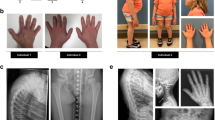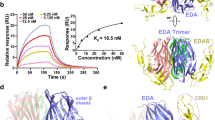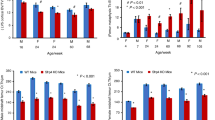Abstract
Gerodermia osteodysplastica is an autosomal recessive disorder characterized by wrinkly skin and osteoporosis. Here we demonstrate that gerodermia osteodysplastica is caused by loss-of-function mutations in SCYL1BP1, which is highly expressed in skin and osteoblasts. The protein localizes to the Golgi apparatus and interacts with Rab6, identifying SCYL1BP1 as a golgin. These results associate abnormalities of the secretory pathway with age-related changes in connective tissues.
This is a preview of subscription content, access via your institution
Access options
Subscribe to this journal
Receive 12 print issues and online access
$209.00 per year
only $17.42 per issue
Buy this article
- Purchase on Springer Link
- Instant access to full article PDF
Prices may be subject to local taxes which are calculated during checkout

Similar content being viewed by others
Accession codes
References
Hunter, A.G. J. Med. Genet. 25, 854–857 (1988).
Rajab, A. et al. Am. J. Med. Genet. A. 146, 965–976 (2008).
Martin, G.M. Cell 120, 523–532 (2005).
Pedersen, A.G. & Nielsen, H. Proc. Int. Conf. Intell. Syst. Mol. Biol. 5, 226–233 (1997).
Short, B., Haas, A. & Barr, F.A. Biochim. Biophys. Acta 1744, 383–395 (2005).
Barr, F.A. & Short, B. Curr. Opin. Cell Biol. 15, 405–413 (2003).
Di, Y. et al. J. Hum. Genet. 48, 315–321 (2003).
Schmidt, W.M. et al. EMBO Rep. 8, 691–697 (2007).
Schmid, E.M. et al. PLoS Biol. 4, e262 (2006).
Burman, J.L. et al. J. Biol. Chem. 283, 22774–22786 (2008).
Grigoriev, I. et al. Dev. Cell 13, 305–314 (2007).
Mallard, F. et al. J. Cell Biol. 156, 653–664 (2002).
Sun, Y. et al. Mol. Biol. Cell 18, 4129–4142 (2007).
Wu, X. et al. Nat. Med. 10, 518–523 (2004).
Kornak, U. et al. Nat. Genet. 40, 32–34 (2008).
Acknowledgements
We are grateful to all participants in this study. We thank J. Evans, B.N. Chodirker and K. Wrogemann for their support. We wish to thank F. André, B. Fischer, S. Kolberg and N. Wittstruck for technical assistance. This work was funded by grants from the German Federal Ministry of Education and Research and the Ministry for Innovation, Science, Research, and Technology of the Land Nordrhein Westfalen to H.C.H. and by funds from the Deutsche Forschungsgemeinschaft (collaborative research centre 577) to U.K. The sample IG was obtained from the “Cell line and DNA Bank from patients affected by Genetic Diseases” collection (http://www.gaslini.org/labdppm.htm) supported by Italian Telethon grants. We thank H. Zentgraf for the generation of monoclonal antibodies.
Author information
Authors and Affiliations
Contributions
H.C.H. performed genetic analysis and wrote the manuscript; U.K. performed genetic and functional analysis and wrote the manuscript; H.Z., X.Z., W.S. and J.K. were involved in functional assays; J.E. and F.A.B. did the interaction screening; B.B., M.N. and P.N. performed genetic mapping; F.B., W.R.W., D.M., P.B.K., A.R., G.Z., V.F., B.D., W.N., K.M., J.C.-S., M.T., B.S. and P.W. provided samples from affected individuals and additional mapping information; S.M. initiated the study and wrote the manuscript.
Corresponding author
Supplementary information
Supplementary Text and Figures
Supplementary Methods, Supplementary Note, Supplementary Table 1 and Supplementary Figures 1–5 (PDF 3487 kb)
Rights and permissions
About this article
Cite this article
Hennies, H., Kornak, U., Zhang, H. et al. Gerodermia osteodysplastica is caused by mutations in SCYL1BP1, a Rab-6 interacting golgin. Nat Genet 40, 1410–1412 (2008). https://doi.org/10.1038/ng.252
Received:
Accepted:
Published:
Issue Date:
DOI: https://doi.org/10.1038/ng.252



